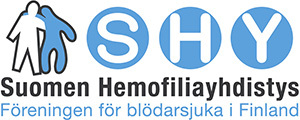Bleeding disorders that occur even more rarely than haemophilia are called rare bleeding disorders. Haemophilias together with von Willebrand disease represent the great majority of hereditary bleeding disorders (95–97%) and only about 3–5% are rare coagulation factor deficiencies. In these, bleeding symptoms are generally milder than in haemophilia and vary between different coagulation factor deficiencies and patients. Symptoms may not always be in direct correlation with the level of coagulation factors.
Rare bleeding disorders are inherited recessively from both parents and are not tied to sex. In carrier parents, the level of a coagulation factor can be mildly lowered, since they have one normally functioning gene. Bleeding disorder occurs in children who inherit the abnormal gene from both parents. However, there are exceptions, and some of the people with one abnormal gene do have a bleeding tendency, just like some haemophilia carriers. In the same family there can be members with one, two, or no abnormal versions of the gene.
Factor I (fibrinogen) deficiency
Disorders related to coagulation factor I (fibrinogen; factor one, FI) are due to the deficiency or functional defect of the coagulation factor, or the combination of both. Fibrinogen deficiency may cause bleeding symptoms, whereas abnormal structure of the protein can result in either excessive bleeding or coagulation tendencies.
Factor II (prothrombin) deficiency
Typical symptoms of coagulation factor II (prothrombin; factor two, FII) deficiency are a tendency for skin and mucosal bleeds, such as bruising, nose bleeds and heavy menstruation. Additionally, there may be joint and muscle bleeds. The severity of bleeding symptoms correlates with the level of the coagulation factor.
Factor V deficiency
Coagulation factor V (factor five, FV) is an enzyme that has an important part in the formation of thrombin, a central component of blood coagulation. The symptoms vary, and severe deficiency is associated with a higher risk for severe bleeding, such as intracranial and joint bleeds. Bleeding symptoms also include bruising tendency, mucosal bleeds in the nose and mouth, and heavy menstruation.
Factor VII deficiency
Factor VII (factor seven, FVII) is the most common of the rare bleeding disorders, and symptoms can vary from mild to severe Typical symptoms include a tendency for bruising, nose bleeds, heavy menstruation, intestinal bleeding and urinary tract bleeding. In severe cases (FVII level below 1%), symptoms may include joint and muscle bleeds as well as intracranial bleeds.
Factor X deficiency
Factor X (factor ten, FX) is a vital protein, and its complete absence prevents foetal development. Symptoms vary individually and are related to the level of the coagulation factor. Typical symptoms are nose bleeds, heavy menstruation, childbirth bleeds and bleeding in connection to operations and procedures. In severe FX deficiency (FX level below 1%), joint and muscle bleeding and intracranial bleeds may also occur.
Factor XI deficiency (type C haemophilia)
Type C haemophilia can have variable manifestations and bleeding symptoms can be mild, even if the level of factor XI (factor eleven, FXI) is very low. Thus, a severe type C haemophilia differs significantly from severe type A and B haemophilia. Spontaneous bleeds and joint bleeding are rare and sometimes there are hardly any bleeding symptoms.
Factor XIII deficiency
Coagulation factor XIII (factor thirteen, FXIII) is responsible for stabilising blood clots by binding fibrin strands together. Typical symptoms of FXIII deficiency include umbilical bleeding in newborns, a tendency for bruising, joint bleeds, and increased risk of sudden cerebral haemorrhage.
More info on rare bleeding disorders can be found in our guide.
Duodecim Terveyskirjasto and the Verenvuotaudit — Tietopaketti potilaille guide have been used as text references.
